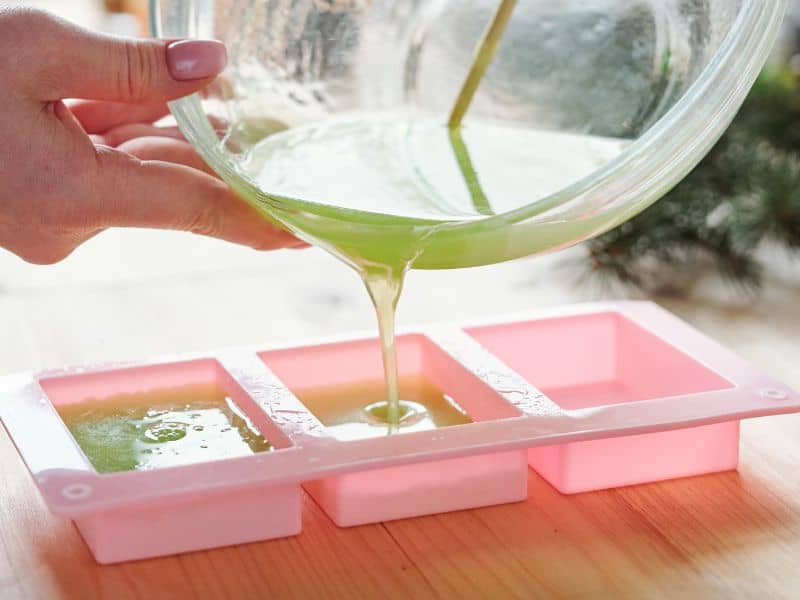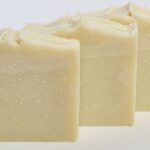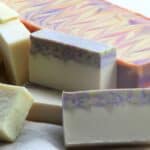Are you ready to dive into DIY soap-making but feeling a bit unsure about how much melt and pour soap base you need for your project? We will walk you through the process of calculating the perfect amount of soap base to fill your soap molds or soap loaf molds.
Calculate how much melt and pour soap you need by multiplying the length, by the depth, by the width to get the cubic inches of the mold then multiply that by .40 to get the total ounces. Add a little extra for additives. This will give you the amount of melt and pour soap needed.
Then divide that by 16 to get the total pounds. This will give you an idea how much melt and pour soap base you will need based on the dimensions of your soap molds.
However, remember that using additives in your soap can change the volume. If you are using a lot of additives, you may want to use a bit less soap base so that it all fits, or leave another mold on standby. Let’s take a look at some more details on this topic.
How to Calculate Soap Base Amount
Measuring mold volume
To determine how much melt and pour soap base you need, start by measuring your mold’s volume.
For individual soap molds, fill the cavity with water and pour it into a measuring cup. Note the fluid ounces (oz) or milliliters (ml) of water.
For soap loaf molds, measure the length, width, and depth in inches or centimeters. Multiply these three measurements to find the volume in cubic inches or cubic centimeters.
Converting volume to weight
Next, convert the mold volume to weight. Most soap bases use ounces (oz) or grams (g) as the unit of measurement.
To convert fluid ounces (from individual soap molds) to ounces, multiply by 1.04.
For milliliters, multiply by 0.96 to get grams. For cubic inches (from soap loaf molds), multiply by 0.57 to get ounces, or by 16.39 for grams. For cubic centimeters, multiply by 0.96 to get grams.
Factoring in additives and decorations
Remember to account for additives and decorations like colorants, fragrances, and exfoliants.
While they may not add significant weight, it’s a good idea to slightly increase the calculated soap base amount by about 5% to ensure adequate coverage.
How Much Do Soap Molds Hold?
Soap molds come in a variety of shapes and sizes. The amount they can hold will depend on what you are working with.
Here are some average sizes of soap molds you might experience, listed in oz and grams.
Individual soap molds
Sizes can vary depending on the shape and design.
Here are some common sizes:
- Small (1.5 oz / 43 g)
- Medium (3 oz / 86 g)
- Large (4.5 oz / 128 g)
Soap loaf molds
Soap loaf molds also come in various sizes.
Here are a few standard sizes:
- Mini (24 oz / 680 g)
- Regular (40 oz / 1,134 g)
- Large (70 oz / 1,985 g)
Custom and unique mold options
Custom and unique molds can hold different amounts of soap base.
Some examples include:
- Silicone cupcake molds (3 oz / 86 g)
- Small decorative shapes (2 oz / 57 g)
- Large novelty molds (6 oz / 170 g)
Stress Free Soap Making With Multi-Pouring
Embrace the ease of multi-pouring for a stress-free soap-making experience. This technique eliminates the need for perfect calculations by allowing you to pour excess soap into a second mold.
Begin by gathering multiple soap molds and preparing your soap base with desired additives. Pour the melted soap into the first mold and simply transfer any excess to the second mold. This approach prevents underfilling or overfilling molds, saving time and materials while encouraging creativity with various mold shapes and designs.
When the soap in the second mold hardens, spray the surface of the partially filled section with rubbing alcohol to ensure strong adhesion between pours, preventing separation as the soap hardens.
Multi-pouring offers a relaxed approach to soap making, allowing you to focus on the creative aspects of the craft. Enjoy the process and produce stunning soaps with confidence and ease.
Tips for a Successful Soap-Making Experience
Preparing your workspace
Before starting your soap-making project, prepare a clean and organized workspace. Gather all your supplies, including soap base, molds, measuring tools, fragrance, colorants, and additives.
Cover your work surface with a protective layer, like wax paper or a silicone mat, to prevent spills and stains.
Make sure your area is well-ventilated and has access to a microwave or double boiler for melting soap base.
Melting and mixing soap base
To melt your soap base, cut it into small, evenly-sized pieces. This helps it melt faster and more evenly. Use a microwave-safe container or a double boiler for melting.
Heat the base in 30-second intervals, stirring gently between each interval to prevent overheating.
Once the base is fully melted, add your chosen colorants, fragrances, and additives. Stir slowly and thoroughly to avoid creating bubbles.
Cooling and unmolding your soap
Pour the melted soap base into your prepared mold, filling it to the desired level. If bubbles appear on the surface, lightly spritz with rubbing alcohol to remove them.
Allow the soap to cool and harden at room temperature for several hours or overnight.
To remove the soap from the mold, gently press on the bottom or sides of the mold to release the soap. If needed, use a blunt object to carefully push the soap out.
Troubleshooting Common Issues
Overfilled or underfilled molds
If your molds are overfilled, use a clean spatula to remove excess soap base and level the surface.
For underfilled molds, re-melt additional soap base and add it to the mold until the desired level is reached. Remember to adjust your calculations for future projects to prevent these issues.
Bubbles and surface imperfections
Bubbles often result from vigorous stirring or pouring the soap base too quickly. To avoid bubbles, stir gently and pour slowly. If bubbles form on the surface, spritz with rubbing alcohol immediately after pouring to remove them.
For other imperfections, like dents or rough edges, use a clean, damp cloth to gently smooth the soap’s surface.
Uneven soap texture
Uneven texture might be caused by insufficient stirring or additives not fully incorporated. To prevent this, ensure that your soap base, colorants, fragrances, and additives are mixed thoroughly before pouring into the mold.
If you encounter uneven texture in your finished soap, consider melting and re-pouring it with the proper technique to achieve a smoother result.
Frequently Asked Questions
Multiply fluid ounces by 1.04 for ounces or milliliters by 0.96 for grams. For cubic inches, multiply by 0.57 for ounces or 16.39 for grams. For cubic centimeters, multiply by 0.96 for grams.
Yes, add a little extra soap base (about 5%) to account for the weight of additives and decorations like colorants, fragrances, and exfoliants.
Yes, create layers by pouring different colored soap bases into the mold, allowing each layer to cool slightly before adding the next one. You can also use swirling techniques for a marbled effect.
If overfilled, use a clean spatula to remove excess soap base and level the surface. For underfilled molds, re-melt additional soap base and add it to the mold until the desired level is reached. Adjust your calculations for future projects to prevent these issues.
Conclusion
In conclusion, calculating the right amount of melt and pour soap base for your mold is crucial for successful soap-making projects. By measuring your mold’s volume, converting it to weight, and accounting for additives, you can create stunning homemade soaps with ease.
Don’t forget to follow our tips for a smooth soap-making experience and troubleshoot common issues as needed. With practice and creativity, you’ll become a skilled soap maker, ready to craft unique and beautiful soaps for yourself and your loved ones.






